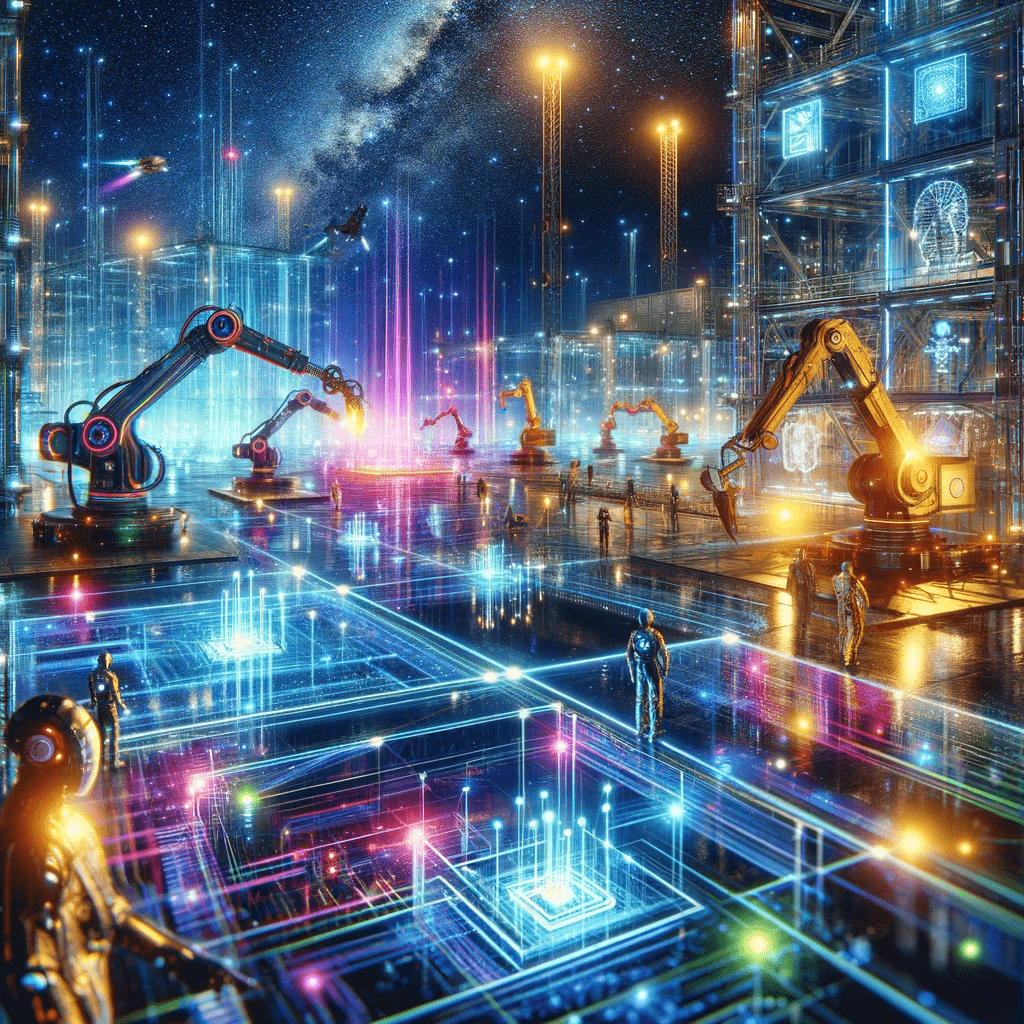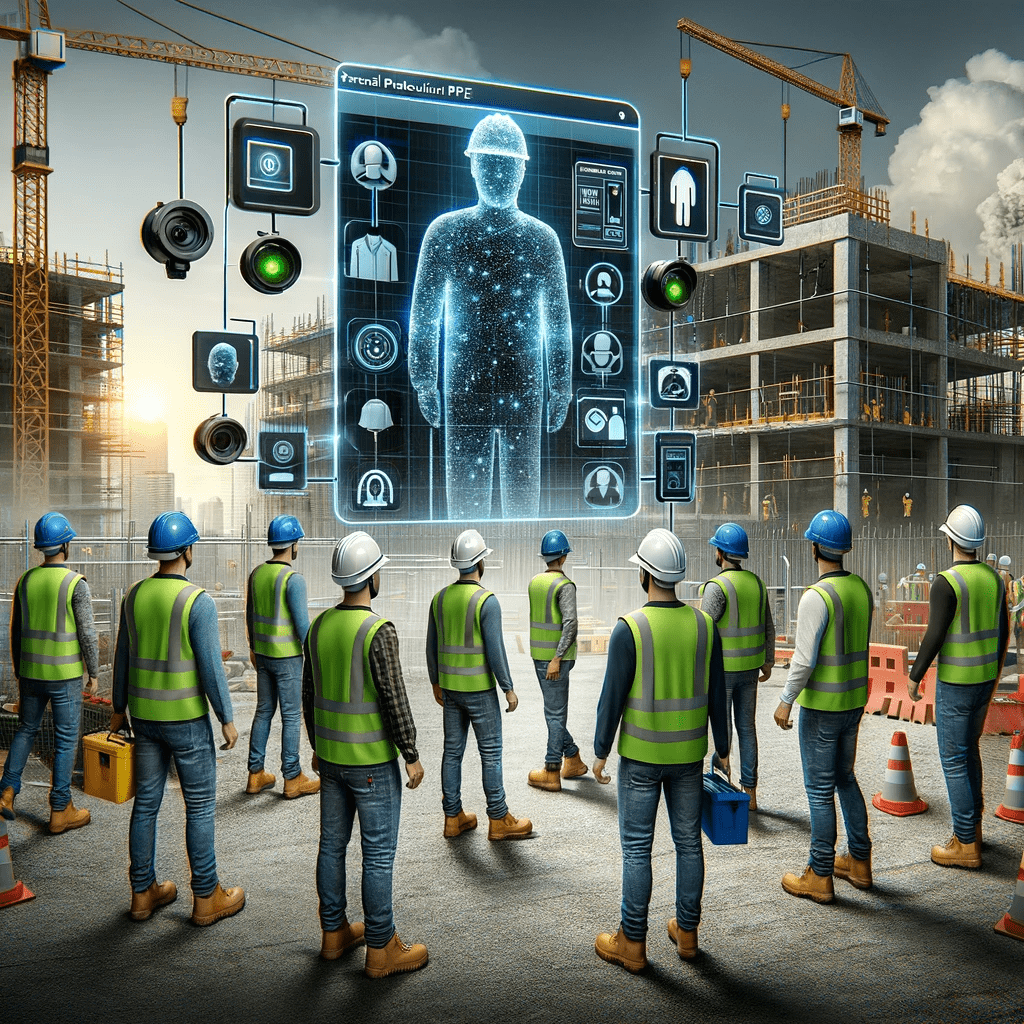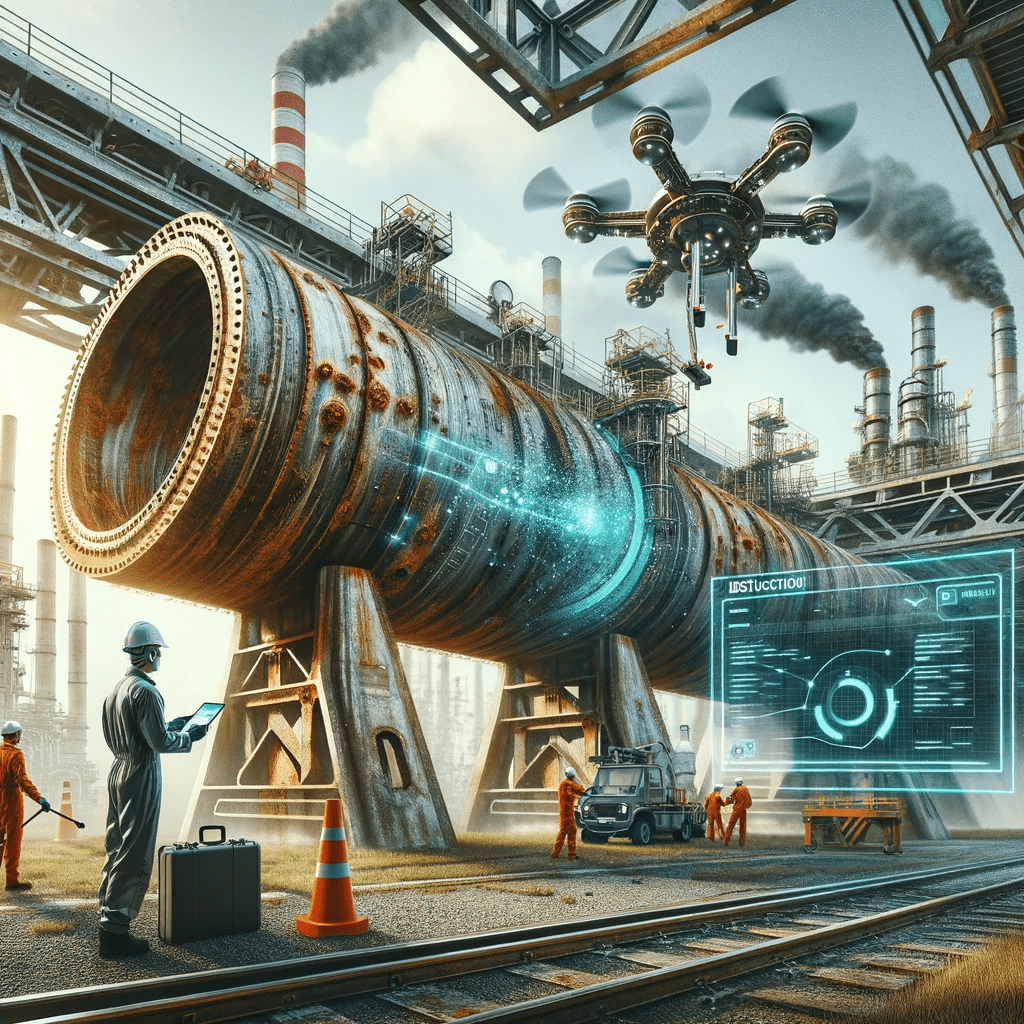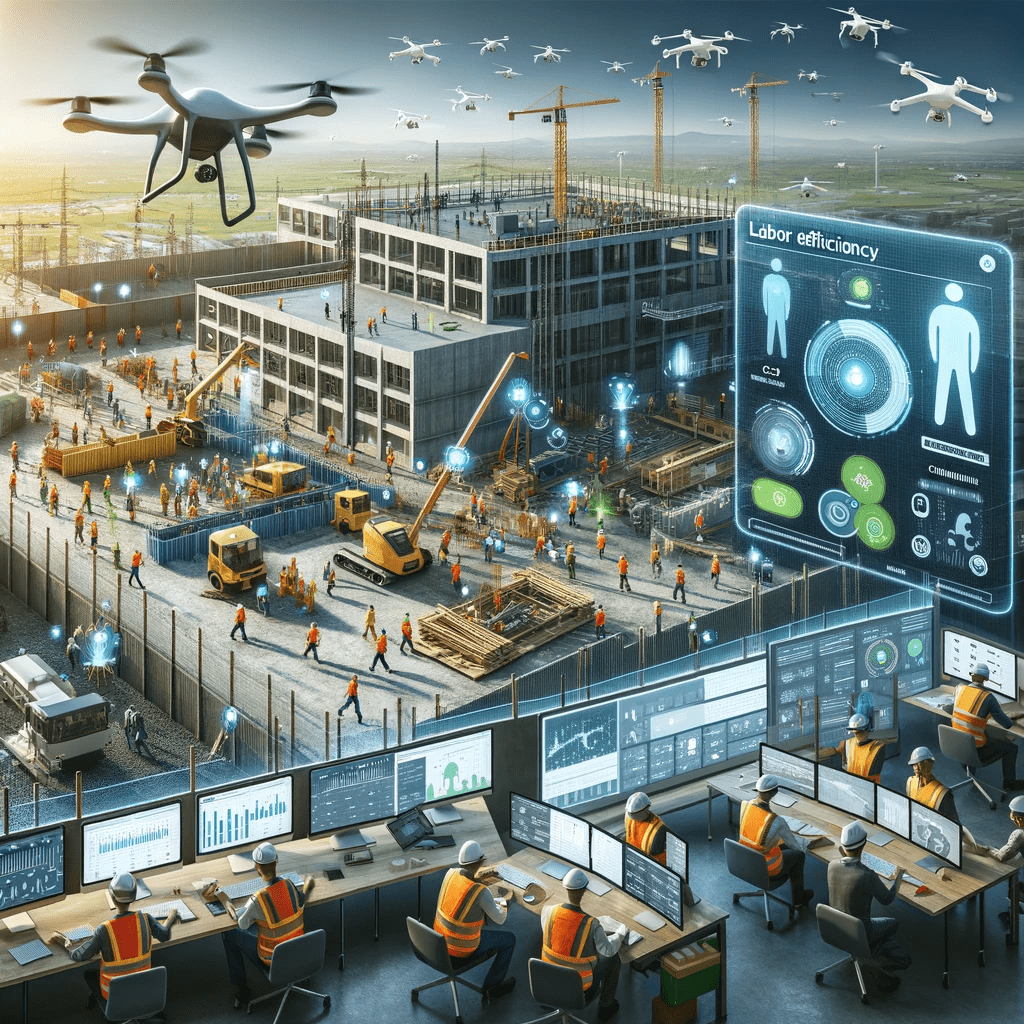Contents
As a rule, managing a construction project relies on human knowledge and experience.
This works, but…
It has some drawbacks that affect efficiency and consistency.
Today, we face new challenges like a shortage of workers, increased government involvement, and the need to save costs. To tackle these issues, people have started using AI (Artificial Intelligence) to assist in construction projects.
AI technologies can greatly enhance the efficiency of construction projects in terms of time, labor, and cost.
These benefits are not just theoretical; they have practical applications.
In this article, we will explore the most important ways AI is currently being used in construction. Let’s take a look!
Generative AI Applications For Construction

Powerful Generative AI Models can generate detailed 3D models, construction plans, and project specifications with just a few prompts. This automates and accelerates early design phases. Generative AI also enhances collaboration – stakeholders can iterate and provide feedback on generated drafts.
During construction, generative AI assists in optimizing schedules, logistics, and workflows. It can identify risks and inefficiencies. Post-construction, generative AI analyzes data to derive insights and best practices for future projects.
Let’s know all this information in detail in the following section.
1. Personal Protective Equipment (PPE) Detection

Protective equipment can save lives, but only if people wear it.
According to the National Institute for Occupational Safety and Health (NIOSH), roughly 2,000 workplace injuries happen each day in the U.S. that could be prevented through protective equipment.
Construction managers have limited time and eyesight, so it’s hard for them to ensure everyone is wearing the right protective gear.
But technology can help.
Artificial intelligence (AI) can identify different types of protective equipment like hard hats, gloves, and goggles. AI detects objects through deep learning techniques that use lots of images to train a model.
Once trained, AI models can recognize safety gear in images with high accuracy. This means that cameras installed on construction sites can act as extra eyes, assisting construction managers in ensuring the safety of their workers.
A study developed a system that could detect 8 types of protective equipment and 9 postures in real time. Using 95 videos of construction sites, the model was able to identify the gear and body positions.
When tested on new footage, the system correctly identified the protective equipment over 83% of the time and spotted missing gear over 95% of the time. Monitoring protective equipment used on construction sites can be done with AI to improve safety.
2. Detect Corrosion

Keeping workers safe through protective equipment and hazard monitoring is one way AI helps construction sites. Because using image classification, AI can also detect corrosion.
Detection of corrosion is necessary. Otherwise, it can pose a significant threat to construction operations and human safety. Corrosion can lead to machinery and structures breaking down, resulting in increased maintenance costs, environmental harm, injuries, and even loss of life.
Currently, certified inspectors check for corrosion, but it’s subjective and prone to error. Given the high stakes involved, it would help site managers to have consistent and objective corrosion detection.
For example, Infosys and other companies are developing AI solutions based on neural networks to reliably and consistently detect and classify corrosion.
Can AI detect such small changes?
Yes! The algorithm does two things –
- It identifies types of corrosion and differentiates between coating loss and actual rust in various types of corrosion.
- It determines how severe the corrosion is.
Hence, AI can consistently detect corrosion earlier and more accurately than human inspectors. This helps construction managers fix issues before they cause more serious problems.
3. Detect Workplace Hazard
While monitoring PPE compliance can improve safety, workers still need to watch for hazards themselves.
The Health and Safety Executive in the UK reported 142 worker deaths in 2019/2020 and 693,000 injuries. The cost of construction injuries was £16.2 billion that year. Clearly, keeping construction workers safe is a significant responsibility.
But, AI-based computer vision solutions have been developed to track, predict, and prevent workplace accidents. In simple terms, its object-tracking technique can identify hazards like flammable materials and warn managers and workers in real-time.
A platform called IRIS uses AI to create a virtual map of the work area from CCTV. It notifies workers of hazards via WhatsApp, SMS, alarms or through other messaging apps. Their AI detects forklifts and raises alarms if they’re moving unsafely. It can also identify fires earlier than traditional systems.
Computer vision can monitor worker posture and pose, using techniques like human pose estimation, to prevent injuries from improper lifting or manual handling. If workers are at risk of harming themselves, AI models issue warnings.
Everguard uses computer vision, wearables, and sensors to improve safety with PPE detection, fall detection, forklift safety, anti-collision, crane detection, and posture detection.
Some AI, like IntenseEye, prioritizes both safety and privacy. They process visual data, delete it, and blur faces to ensure anonymity. Hence, they don’t store any personal information and focus on safety, not surveillance.
So, there’s no need to worry that an intrusive presence is watching over the workplace. The primary focus of these AI technologies is safety.
4. Auditing Infrastructure Assets
Traditionally, humans have been responsible for observing and judging the condition of these assets, like checking for corrosion. However, human assessment can be inconsistent and unreliable, which wastes time and resources.
But, with the help of AI systems like computer vision is helping human inspectors to make more objective assessments. These systems analyze images or video footage of the assets through cameras and advanced algorithms. Thus, they can provide more accurate and reliable information.
One of the advantages of using computer vision for infrastructure inspection is the ability to monitor construction sites remotely. Remote monitoring allows real-time tracking of:
- Infrastructure assets
- Construction progress
- Building information models (BIM)
These AI systems can track progress on a construction project as a whole, as well as identify individual assets, track user information, and track maintenance requirements.
This further help in finding problems like cracks, concrete spalling, leakages, or other type of damages and informing inspectors/managers immediately.
5. Performing Predictive Maintenance
Keeping people safe and healthy on a construction site is extremely important, but it’s also crucial for construction managers to take care of the equipment being used.
According to McKinsey, construction managers can increase machine longevity by 20-40% and reduce the amount of time machines are out of service by 30-50% by using a technique called predictive maintenance.
Replacing equipment is costly, so identifying issues early is a better chance of fixing it before it becomes a bigger issue. While humans can inspect and identify problems, they can’t do it reliably 24/7. Thankfully, AI and machine learning can.
But, training machine learning systems with a large amount of historical data can start predicting when and what type of maintenance will be needed for a specific set of equipment. Using sensors connected to the Internet of Things (IoT), the AI model can detect defects more accurately and improve its predictions.
Hence, having proper functioning equipment is able to predict when maintenance is required to solve business problems and makes decision-making more efficient.
Yes, it’s true that construction managers still need to check this data and make decisions accordingly. However, always remember that data-driven predictions will only help them to do this better.
6. Monitoring Labor Efficiency

Measuring labor efficiency on construction sites is expensive, time-consuming, and requires labor. And ultimately, the results are not all that reliable.
For example, it is already challenging to track and measure the productivity of a single worker. But when multiple workers collaborate to complete a task, it becomes even more difficult to assess their productivity accurately.
As a result, construction managers often only assess labor efficiency when a noticeable problem arises. Unfortunately, this means that many opportunities for improving efficiency are overlooked entirely.
However, using AI-powered systems like computer vision, several cameras were installed to measure labor efficiency much easier.
Computer vision techniques like object detection and pose estimation can monitor worker activity. But it’s not a straightforward task. Background clutter, obstructions, and workers wearing similar uniforms can make tracking workers challenging.
Due to this reason, researchers have proposed frameworks that use cameras and computer vision to track worker trajectories over time as a 4D data set. This data can then be converted into productivity measurements.
In studies, these frameworks determined time-on-task for single and multiple workers with a high degree of accuracy (84% to 95% accuracy). Though room for improvement remains.
Hence, computer vision shows promise for measuring labor efficiency better than human observation across an entire job site with multiple workers. The accuracy numbers indicate computer vision systems may be able to provide reliable productivity measurements in the future.
7. Land Survey and Mapping
We have already discussed how artificial intelligence (AI) can be used to keep track of and inspect people and objects on a construction site.
But what about surveying the actual site itself?
Having an accurate understanding of the land is extremely important for a construction project to be successful. This helps with planning before construction begins and ensures that the construction is progressing as intended.
To assist with this, companies like Datumate use AI-powered drones and cameras to conduct land surveys and create maps. One of their products, called DatuFly, is a good example of this.
DatuFly takes pictures of the land, construction sites, and infrastructure, and then uploads them to a secure server. Using computer vision and photogrammetry algorithms, the images are transformed into precise 2D and 3D maps and models with geographic references.
Historically, humans have been responsible for land surveying, and they have been quite proficient at it. However, the availability of modern technologies like drones and computer vision techniques has made the process much easier by reducing the time required and increasing accuracy.
The use of AI in construction planning is highly beneficial for project managers and workers because faster and more accurate mapping leads to more efficient construction processes.
Embracing the Future with Generative AI in Construction
In conclusion, the integration of Generative AI in the construction sector heralds a new era of innovation and efficiency. As we’ve explored in this article, this groundbreaking technology has the potential to revolutionize every facet of the construction process, from initial design to project execution. It offers unparalleled advantages in terms of precision, cost-effectiveness, and time management.
RedBlink Technologies stands at the forefront of this technological revolution. Our AI consulting services are specifically tailored to build a Generative AI solution construction industry By partnering with us, you can unlock numerous benefits:
- Innovative Design Solutions: Our AI algorithms can generate a multitude of design variations, enabling you to explore creative and efficient construction solutions that were previously unimaginable.
- Enhanced Efficiency and Precision: By automating and optimizing various construction processes, we help reduce errors, save time, and ensure superior quality outcomes.
- Cost Reduction: Our AI-driven approach significantly lowers the risk of costly mistakes and delays, ensuring that your projects stay within budget.
- Predictive Analysis and Risk Management: We employ advanced predictive models to foresee potential challenges and mitigate risks, safeguarding your projects against unforeseen obstacles.
- Sustainable and Green Solutions: Our AI tools are designed to promote sustainability, aiding in the creation of eco-friendly and energy-efficient structures.
- Customized AI Solutions: At RedBlink, we understand that every construction project is unique. Our team of experts collaborates closely with you to develop bespoke AI solutions that align perfectly with your specific needs and objectives.
In an industry as dynamic and competitive as construction, staying ahead of the curve is crucial. RedBlink’s AI consulting services not only equip you with the latest in AI technology but also provide the strategic insight to leverage this technology effectively. We ensure that your projects not only meet but exceed industry standards, setting new benchmarks in construction excellence.
Why Choose RedBlink for Your AI Journey?
As the construction industry continues to evolve, the adoption of Generative AI is not just an option but a necessity for staying relevant and competitive. RedBlink is your ideal partner in this journey, offering generative AI development services to transform your construction processes and outcomes.
- Expertise and Experience: Our team consists of seasoned professionals who are experts in both AI technology and the construction industry.
- Client-Centric Approach: We prioritize your needs and objectives, ensuring tailor-made solutions that deliver results.
- Cutting-Edge Technology: We stay abreast of the latest advancements in AI to provide you with state-of-the-art solutions.
- Comprehensive Support: From initial consultation to post-implementation, we offer unwavering support throughout your AI journey.
Embrace the future of construction with RedBlink. Let’s build smarter, faster, and more efficiently with the power of AI. Contact us today to learn more about our AI consulting services and how we can help you revolutionize your construction projects.

Director of Engineering | CTO | Software Developer
As a passionate technologist and seasoned software developer, I specialize in creating innovative solutions at the intersection of AI and software engineering. With a keen interest in leveraging the latest technologies to solve real-world problems, my work spans developing advanced AI models to designing scalable software architectures. Beyond coding, I contribute to tech blogs, sharing insights on AI trends, software best practices, and the future of technology. My mission is to empower organizations and individuals through technology, driving forward the boundaries of what’s possible
